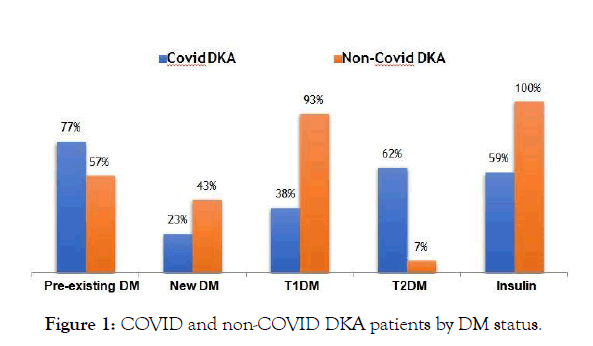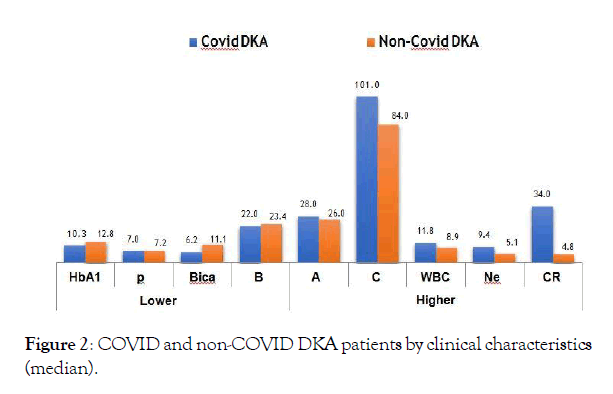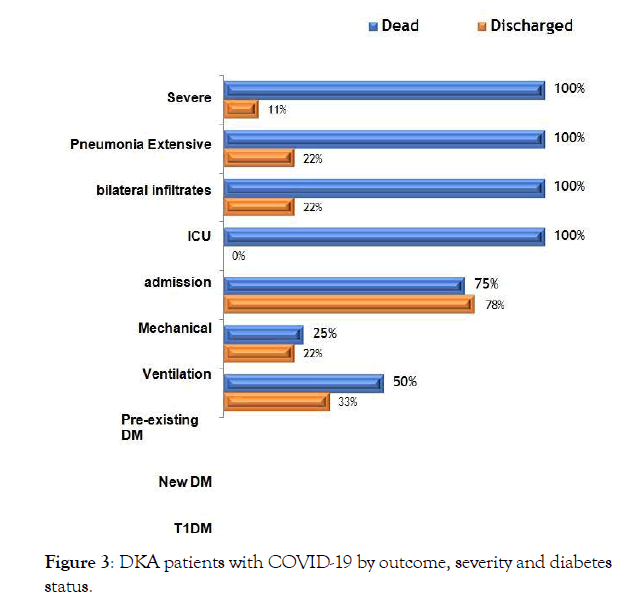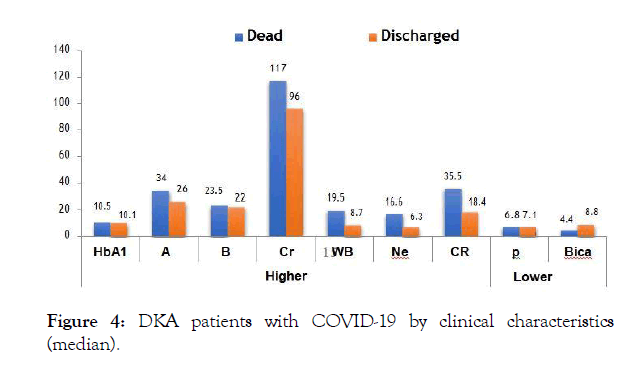Review Article - (2021) Volume 12, Issue 5
Objectives: Diabetic ketoacidosis (DKA) is an acute complication among COVID-19 patients with diabetes mellitus (DM). It is found to be a leading cause of poor prognostic indicators in COVID-19 patients. The aim was to describe the clinical characteristics and outcomes of DKA patients admitted to Suhar Hospital, Oman, investigating the association with COVID-19.
Methods: A retrospective review of DKA patients admitted to Suhar Hospital, Oman, from March 2020 to August 2020. DKA patients will be classified as with or without laboratory- confirmed COVID-19. SPSS, version 22, was used to describe data (median, interquartile range-IQR and percentages) and to test for statistical differences at 5% significance level (chi- square test, Fisher’s exact test and Mann-Whitney U-test).
Results: Twenty seven patients were found to fulfill the criteria of DKA. Of them, 13 patients had confirmed COVID representing a prevalence of 1.4%. COVID DKA patients compared to non-COVID were characterized as being males (54% vs. 43%), older (36 vs. 22), longer on hospital stay (5 vs. 2), had T2DM (62% vs. 7%), admitted to ICU (46% vs. 7%) and higher in mortality (31% vs. 0%) as well as clinically presented with a low pH ( 7 vs. 7.2) and bicarbonate (6.2 vs. 11.1), high serum creatinine (101.0 vs. 84.0) and CRP (34.0 vs. 4.8). Significant factors (p<0.05) found to enhance mortality among COVID DKA patients were COVID pneumonia severity, extensive bilateral radiological infiltrates, ICU admissions, mechanical ventilation, severe metabolic acidosis and higher WBC and Neutrophils. All deceased COVID-19 DKA patients developed complications such as ARDS, renal failure, requiring hemodialysis and septic shock.
Conclusion: This highlights the association of COVID-19 and DKA among T2DM and prolonged hospital stay. Severe COVID pneumonia, severe metabolic acidosis, ICU admissions, mechanical ventilations and high inflammatory markers were poor prognostic factors among COVID-19 patients admitted with DKA.
Diabetic ketoacidosis (DKA); COVID-19; Suhar Hospital; Oman
The noval COVID-19 has been recognized as one of severe and fatal causes for viral pneumonia in the city of Wuhan, China in December 2019 with highly infectivity among humans [1]. As an outbreak, COVID-19 began in china and then has spread to most countries around the world. The number of confirmed cases is increasing dramatically every day [2]. In Oman, the first case was detected on 24th February 2020 and then cases started to increase gradually.
Diabetes mellitus (DM), particularly prolonged uncontrolled, impairs immune system and makes patients at high risk for infection [3]. Previous research on the Middle East Respiratory Syndrome (MERS)-corona, Severe Acute Respiratory Syndrome (SARS) and Community Acquired Pneumonia showed that patients with known DM or newly diagnosed DM are associated with high mortality and morbidity and similarly for COVID-19 [4–7]. Recent studies revealed that hospitalized patients admitted with DM and COVID-19 have prolonged length of admission stay and associates with high mortality rate, especially among elderly compared to young patients [8,9]. In Oman, DM was found to be the most common co- morbidity among hospitalized COVID-19 patients, followed by hypertension, chronic kidney disease and ischemic heart disease [10].
Diabetic ketoacidosis (DKA) is one of acute complications among COVID-19 patients with DM [9]. There are some of poor prognostic indicators in patients who developed DKA during COVID-19 infections like poor blood sugar control, mechanical ventilations and severe metabolic acidosis [9]. DKA occurs mainly in type 1 DM (T1DM) patients due to autoimmune destruction of Beta cells in pancreas which are responsible for insulin secretion. DKA occurs as secondary of relative or absolute insulin deficiency, leading to increased glucose production via gluconeogenesis and glycogenolysis and absolute insulin deficiency stimulating lipolysis, resulting in ketone production [11]. DKA can be presented in COVID-19 among type 2 DM (T2DM) patients triggered by severe infections [12]. Hospitalized DM patients could be already well known to have T1DM, T2DM or undiscovered DM i.e. HbA1c is more than or equal 6.5% otherwise it is a result of stress illness [13].
As DM is a common co-morbidity among COVID-19 patients in Oman [10], there is a need to investigate its complications, especially DKA. Therefore, the aim of this study is to describethe prevalence, clinical characteristics and outcomes in patients with DKA and COVID-19 admitted to Suhar Hospital, Oman
A retrospective review of DKA patients admitted to Suhar Hospital, Oman, from March 2020 to August 2020 was used as a method for the study. DKA patients were classified as with or without laboratory-confirmed COVID-19. DKA was defined as pH<7.3 and/or bicarbonate<18 mmol/L, blood glucose>13.9 mmol/L (250 mg/dL) and high ketones in urine or blood, and increased anion gap metabolic acidosis>12 [14]. The American Diabetes Association classifies DKA by severity as mild, moderate, or severe depending on the degree of acidosis (along with decrease in bicarbonate) and altered sensorium [15]. Al-Shifa’a system was used to extract patients’ demographic, laboratory and clinical characteristics. SPSS, version 22, was used to describe numerical variables (median, interquartile range-IQR) and categorical variables (frequencies and percentages). Due to the small sample size, non- parametric tests were used to investigate the statistical differences and associations at 5% significance level. Chi-square test, Fisher’s exact test and likelihood ratios chi-square test were used to test differences between categorical variables and Mann- Whitney U test was used to investigate differences of categorical variables (with two groups) in term of numerical variables.
This research was approved by the Research and Ethical Review and Approval Committee in North Batinah Governorate (NBG-RERAC15- 2020). Permission from Suhar hospital was achieved to extract patients’ data, and thus no informed consent from patients was required.
A total of 14895 laboratory-confirmed COVID-19 patients were registered in North Batinah Governorate till August, 2020. Of them, 907 patients were admitted to Sohar hospital accounting for 6.1%. A total of 27 patients were found to fulfill the diagnostic criteria for Diabetic Ketoacidosis (DKA) in Suhar hospital during the study period (March-August 2020). Of them, 48% (n=13) cases were reported to present with COVID-19 representing a prevalence of 1.4% of COVID-19 admitted patients (13/907). The majority of DKA patients were females(52%), known diabetic (67%), with T1DM (67%), managed with insulin (74%), without ICU admission (74%) and discharged (85%). DKA patients had a median age of 33 years (IQR=21.0) and admitted for a median of 3 days (IQR=3.0).
Presence of COVID-19
Table 1 shows the characteristics of DKA patients by the presence of COVID-19. The majority of COVID DKA were males (54%), while most non- COVID DKA were females (57%). COVID DKA patients were older compared to non-COVID DKA patients (Median=36 years vs. 22 years) and significantly (p<0.05) had a longer length of stay (Median=5 days vs. 2 days). The majority of DKA patients presented with COVID-19 had pre-existing DM (67%), and the remaining 23% were newly diagnosed during admission. In comparison, 43% of DKA patients without COVID-19 were new DM cases. DKA patients with COVID mainly had T2DM (62%), whereas 93% of DKA patients without COVID had T1DM (Figure 1).
| Characteristics | DKA (n= 27) | Sig. b | ||
|---|---|---|---|---|
| All | COVID (n=13) | Non-COVID (n=14) | ||
| Age in years- Median (IQR) | 33 (21.0) | 36 (15.5) | 22 (19.5) | 0.068 |
| Length of stay in days- Median (IQR) a | 3 (3.0) | 5 (3.0) | 2 (2.0) | 0.001 |
| Gender- n (%) | 0.706 | |||
| Male | 13 (48%) | 7 (54%) | 6 (43%) | |
| Female | 14 (52%) | 6 (46%) | 8 (57%) | |
| DM- n (%) | 0.42 | |||
| Known | 18 (67%) | 10 (77%) | 8 (57%) | |
| Unknown | 9 (33%) | 3 (23%) | 6 (43%) | |
| DM Type- n (%)a | 0.004 | |||
| T1DM | 18 (67%) | 5 (38%) | 13 (93%) | |
| T2DM | 9 (33%) | 8 (62%) | 1 (7%) | |
| DM Management (Rx) a | 0.018 | |||
| Insulin | 14 (74%) | 5 (50%) | 9 (100%) | |
| Oral hypoglycemic agents | 4 (21%) | 4 (40%) | 0 (0%) | |
| Diet | 1 (5%) | 1 (10%) | 0 (0%) | |
| ICU- n (%) a | 0.033 | |||
| Yes | 7 (26%) | 6 (46%) | 1 (7%) | |
| No | 20 (74%) | 7 (54%) | 13 (93%) | |
| Outcome- n (%) a | 0.041 | |||
| Died | 4 (15%) | 4 (31%) | 0 (0%) | |
| Discharged | 23 (85%) | 9 (69%) | 14 (100%) | |
| Clinical Characteristics- Median (IQR) | ||||
| HbA1c | 10.9 (4.4) | 10.3 (3.2) | 12.8 (5.1) | 0.242 |
| pH | 7.1 (0.4) | 7.0 (0.4) | 7.2 (0.2) | 0.124 |
| Anion Gap (AG) | 26.5 (8.3) | 28.0 (8.0) | 26.0 (6.0) | 0.155 |
| Bicarbonate | 7.6 (10.7) | 6.2 (9.6) | 11.1 (9.9) | 0.244 |
| Glucose | 23.0 (12.0) | 22.0 (14.5) | 23.4 (11.7) | 0.865 |
| Creatinine a | 90 (34.0) | 101.0 (13.0) | 84 (27.0) | 0.011 |
| White blood cells (WBC) | 9.2 (10.6) | 11.8 (12.0) | 8.9 (8.8) | 0.344 |
| Neutrophils | 6.6 (9.4) | 9.4 (14.3) | 5.1 (9.6) | 0.12 |
| C-reactive Protein (CRP) a | 12.5 (32.1) | 34.0 (121.1) | 4.8 (13.8) | 0.029 |
aSignificant at 0.05
bChi-square test (or Fisher’s exact test or likelihood ratios) for categorical variables
bMann-Whitney U test for numerical variables
Table 1: Characteristics of DKA patients with or without infection with COVID-19.

Figure 1: COVID and non-COVID DKA patients by DM status.
All non-COVID patients had normal CXR, while 62% of COVID patients had bilateral radiological infiltrates (15 % with minimal and 46 % with extensive infiltrates). Six of DKA patients with COVID (46%) were admitted to the ICU compared to just one DKA patient without COVID (7%). Almost a third (31%) of DKA patients with COVID required mechanical ventilation (MV) compared to none of the DKA patients without COVID. Four DKA patients with COVID (33%) died compared to zero death among DKA patients without COVID. Both COVID and non-COVID patients had higher HbA1c (Median 10.3 vs. 12.8). Based on DKA criteria, COVID patients presented with lower pH (Median=7.0 vs. 7.2), lower bicarbonate (Median=6.2 vs. 11.1), and higher AG (Median=28.0 vs. 26.0). These indicated the severity of DKA among the COVID group. Furthermore, DKA patients with COVID presented significantly (p<0.05) with a higher values of serum Creatinine (Median=101.0 vs. 84.0) and CRP (Median=34.0 vs. 4.8) as well as a higher values of WBC (Median=11.8 vs. 8.9) and Neutrophils (Median=9.4 vs. 5.1) (Figure 2).

Figure 2: COVID and non-COVID DKA patients by clinical characteristics (median).
DKA Patients with COVID-19
The mortality proportion among DKA patients presented with COVID was 31% (n=4). Table 2 presents the investigation of characteristics that enhanced the occurrence of deaths among COVID DKA patients.Died DKA patients were slightly older than discharged patients (Median=37.5 vs. 36.0) with a higher length of stay (Median=5.5 vs. Mean=5.0). Deaths were equally distributed between males (50%) and females (50%).
| Characteristics | COVID DKA (n=13) | Sig. b | |
|---|---|---|---|
| Died (n=4) | Discharged (n=9) | ||
| Age in years- Median (IQR) | 37.5 (10.8) | 36 (33) | 0.816 |
| Length of stay in days- Median (IQR) | 5.5 (11.5) | 5 (3.5) | 0.64 |
| Sex | 1 | ||
| Male | 2 (50%) | 5 (56%) | |
| Female | 2 (50%) | 4 (44%) | |
| Covid Severity a | 0.004 | ||
| Asymptotic to Mild | 0 (0%) | 3 (33%) | |
| Mild to Moderate | 0 (0%) | 5 (56%) | |
| Severe /critical | 4 (100%) | 1 (11%) | |
| Chest x-ray (bilateral infiltrates) a | 0.015 | ||
| Normal | 0 (0%) | 5 (56%) | |
| Minimal | 0 (0%) | 2 (22%) | |
| Extensive | 4 (100%) | 2 (22%) | |
| ICU* (Intensive care unit) a | 0.021 | ||
| Yes | 4 (100%) | 2 (22%) | |
| No | 0 (0%) | 7 (78%) | |
| Mechanical Ventilation (MV) a | 0.001 | ||
| Yes | 4 (100%) | 0 (0%) | |
| No | 0 (0%) | 9 (100%) | |
| Known DM | 1 | ||
| Yes | 3 (75%) | 7 (78%) | |
| No | 1 (25%) | 2 (22%) | |
| DM Type | 1 | ||
| T1DM | 2 (50%) | 3 (33%) | |
| T2DM | 2 (50%) | 6 (67%) | |
| DM Management (Rx) | 0.61 | ||
| Insulin | 2 (67%) | 3 (43%) | |
| Diet | 0 (0%) | 1 (14%) | |
| Oral hypoglycemic agents | 1 (33%) | 3 (43%) | |
| Clinical Characteristics- Median (IQR) | |||
| HbA1c | 10.5 (0.04) | 10.1 (4.7) | 0.782 |
| pH a | 6.8 (0.08) | 7.1 (0.3) | 0.008 |
| Anion Gap (AG) | 34 (9.8) | 26.0 (7.0) | 0.052 |
| Bicarbonate a | 4.4 (3.6) | 8.8 (10.7) | 0.031 |
| Glucose | 23.5 (24.3) | 22.0 (14.5) | 1 |
| Creatinine a | 117 (108.5) | 96.0 (37.0) | 0.247 |
| White blood cells (WBC) a | 19.5 (15.1) | 8.7 (6.7) | 0.031 |
| Neutrophils a | 16.6 (12.0) | 6.3 (6.0) | 0.031 |
| C-reactive Protein (CRP) a | 35.5 (89.3) | 18.4 (192.3) | 0.643 |
a Significant at 0.05
b Chi-square test (or Fisher’s exact test or likelihood ratios) for categorical variables
b Mann-Whitney U test for numerical variables
Table 2: Characteristics of DKA patients with COVID-19 by outcome.
The outcome was associated with the severity of the COVID-19 conditions (p<0.05). All deceased patients presented with severe COVID pneumonia (100% vs. 11%), had extensive bilateral radiological infiltrates (100% vs. 22%), required ICU admissions (100% vs. 24%), and mechanical ventilations (100% vs. 0%). Compared to discharged patients, the majority of dead patients had pre-existing DM (75% vs. 78%), and the remaining (25% vs. 22%) were newly diagnosed during admission, as well as half of the dead patients had T1DM (50% vs. 33%) (Figure 3). In contrast to discharged COVID DKA patients, died patients significantly (p<0.05) presented withsevere DKA (Median PH=6.8 vs. 7.1 and Bicarbonate=4.4 vs. 8.8) as well as significantly (p<0.05) higher levels of inflammatory markers (Median WBC=19.5 vs.8.7 and Neutrophils=16.6 vs. 6.3) (Figure 4). Further exploration of the comorbidities among dead patients showed that none of them had been diagnosed with hypertension or ischemic heart disease. They developed complications such as ARDS, MV, RF and septic shock while only one of them developed MI.

Figure 3: DKA patients with COVID-19 by outcome, severity and diabetes status.

Figure 4: DKA patients with COVID-19 by clinical characteristics (median).
In this retrospective observational study, we aimed to assess the clinical characteristics and outcomes of COVID-19 illness with diabetic ketoacidosis among hospitalized patients from March to August 2020. Few studies highlighted the presence of DKA among admitted COVID- 19 patients [12,16-19] and nationally, this is the first to our knowledge. Compared to previous studies, the current one provided analysis of 27 DKA cases of which 13 cases presented with confirmed COVID-19. This study estimated the prevalence of DKA among COVID-19 patients admitted to a secondary care hospital of 1.4%. This can be considered high prevalence concordant with a previous finding of 1.8% [18]. It is also high in terms of proportion (48%) out of total admitted DKA patients.
Compared to non-COVID DKA patients, most DKA patients with COVID-19 were males and older, and this result is similar to previous findings [18–20] and the prolonged length of hospital stay [16]. The findings showed that patients with confirmed COVID-19 had severe DKA compared to non-COVID patients as they presented with lower pH and bicarbonate and ahigher anion gap. This is explained by the unique pathophysiology of direct effects of SARS- CoV-2 on the pancreas via ACE2 receptors leading to damage of islets cells [21].
The association of COVID-19 with diabetes has been reported particularly among hospitalized patients [16,20], which is consistent with Oman [10]. This alarmed the need to investigate COVID-19 patients for DKA occurrence as a potential acute metabolic complication [22]. Previous COVID-19 studies revealed the impact of DM on the severity of COVID-19 as well as on the severity of COVID-19 illness, particularly among uncontrolled DM (either well known or newly discovered), consequently associating with the risk of severe acute complications like DKA and high mortality [4,8,9,12,23–25]. The clinical characteristics found in this study of high HbA1c values among DKA patients, either with (Median>10) or without (Median>12) COVID-19, indicated the alarming issue of uncontrolled DM, which increases the risk of DKA among admitted patients during pandemic era [26]. Recent literature found that patients who presented with severe COVID-19 disease are associated with high mortality [23,27], and this risk increased with the uncontrolled DM and DKA as both are associated with high mortality [23,24].
The current findings showed that, in comparison to discharged patients, all deceased DKA patients presented with COVID-19 had lower pH and bicarbonate while higher in AG and BS. This indicates the severity of DKA with both clinical and radiological severe COVID pneumonia. Besides, all deceased DKA patients required ICU admissions and mechanical ventilations. Therefore, these clinical features found among COVID DKA patients (high HbA1c, severe high anion metabolic acidosis, pH ≤ 6.9, ICU admissions and mechanical ventilations) indicated poor prognostic features. These findings are concordant with the recent literature that revealed the poor prognostic indicators (i.e. poor blood sugar control, mechanical ventilations and severe metabolic acidosis) in patients who developed DKA during COVID-19 infections [9,23,24].
This study had some noteworthy limitations. The study's sample size was small, which may limit the decision regarding the statistical significance versus the clinical effect. Small sample size brings limitations associated with the statistical analysis using non-parametric statistical tests instead of parametric tests [28,29]. This study involved only patients who got admitted to the hospital during the COVID-19 pandemic. The study does not represent stable patients inthe community. Therefore, results can only be generalized to hospitalized patients under similar settings. Also, COVID-19 affects several organs in the body, so some confounders may affect the association between DKA and COVID-19 and not considered in the study.
This study highlights the association between COVID-19 and DKA and its consequences of poor prognosis features and mortality rate of 31%. Admitted DKA patients with COVID-19 had prolonged length of hospital stay, occurred among T2DM, required ICU admissions and mechanical ventilation, and high mortality compared to non-COVID DKA patients. Low prognostic features among COVID-19 patients admitted with DKA include severe COVID pneumonia, severe metabolic acidosis, ICU admissions, mechanical ventilations, and high inflammatory markers. As uncontrolled DM puts patients at high risk for both DKA and severe COVID-19 disease, regular follow up is recommended at the primary care level for diabetic patients to keep their HBA1c less than 6.5-7% as advised by ADA, EASD and AACE. A large sample is required to further investigate and understand the association between DKA and COVID-19 in nature and incidence. This study also highlighted the need to update the guideline for the medical team to deal with DKA patients during the pandemic once admitted to the hospital.
The authors declared no conflict of interest.
This research did not receive any specific grant from funding agencies in the public, commercial, or not-for-profit sectors.
Conception or design: A.K.S., H.K.Z.
Acquisition, analysis, or interpretation of data: A.K.S., H.K.Z. Drafting the work or revising: A.K.S., H.K.Z.
Final approval of the manuscript: A.K.S., H.K.Z.
This research was approved by the Research and Ethical Review and Approval Committee in North Batinah Governorate (NBGRERAC15- 2020).
Citation: Al-Reesi A, Al-Reesi H (2021) Diabetic Ketoacidosis among COVID-19 Patients Admitted to Suhar Hospital, Oman: Clinical Characteristics and Outcomes. J Diabetes Metab 12:866.
Received: 31-Dec-2020 Published: 16-Mar-2021, DOI: 10.35248/2155-6156.21.12.878
Copyright: © 2021 Al-Reesi A, et al. This is an open-access article distributed under the terms of the Creative Commons Attribution License, which permits unrestricted use, distribution, and reproduction in any medium, provided the original author and source are credited.